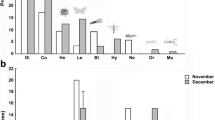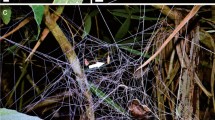Abstract
Predator–prey relationships are generally based on arm-race. Wasps and spiders are both predators, which could be potential prey for each other. The orb weaver spider Zygiella x-notata is sometimes a prey for the wasp Vespula germanica. We observed the wasp hunting behaviour under natural conditions, and we tested the influence of the spider’s behaviour on the wasp attack success. Wasps were active predators during the reproductive period of the spider. Results showed that wasps located more easily male spiders than females particularly when they were engaged in mate guarding. Female location depended on the presence of a web, but also of prey or prey remains in the web. On the other hand, their location depend neither on the characteristics and the position of the retreat in the environment nor on the size of the web. After location, males were more often captured than females whatever their behaviour (mate guarding or not). Presence of prey remains or prey in the web did not increase the risk for the spider to be captured. There was also no influence of the retreat’s characteristics or of its position in the habitat on the risk for the spider to be captured; but wasp successful attacks were less numerous when silk was present around the entrance of the retreat or when the spider was completely inside. As prey and prey remains favoured location of spiders by the wasps, we tested spider web cleaning behaviour as a response to wasp predatory pressure. By throwing small polystyrene pellets in the webs, we observed that more 80% of the spiders rejected the pellets in less than one minute. Our data indicated that wasps were significant predators of Z. x-notata and wasp attack could have been a selective pressure that had favoured spider defensive behaviours such as web cleaning.

Similar content being viewed by others
References
Barr K, Moller H, Christmas E, Lyver P, Beegs J (1996) Impacts of introduced common wasps (Vespula vulgaris) on experimentally placed mealworms in a New Zealand beech forest. Oecologia 105:266–270
Bel-Venner MC, Venner S (2006) Mate guarding strategies and male competitive ability: results from a field study in an orb-weaving spider. Anim Behav 71:1315–1323
Benjamin SP, Zschokke S (2003) Webs of theridiids spiders. Construction, structure and evolution. Biol J Linn Soc 78:293–305
Benjamin SP, Zschokke S (2004) Homology, behaviour and spider webs: web construction behaviour of Lyniphia hortensis and L. triangularis (Araneae: Lyniphiidae) and its evolutionnary significance. J Evol Biol 17:120–130
Blackledge TA (1998). Signal conflict in spider webs driven by predators and prey. Proc Royal Soc Biol Sci 265:1991–1996
Blackledge TA, Pickett KM (2000) Predatory interactions between mud-dauber wasps (Hymenoptera, Sphecidae) and Argiope (Araneae, Araneidae) in captivity. J Archnol 28:211–216
Blackledge TA, Wenzel JW (1999) Do stabilimenta in orb webs attract prey or defend spiders? Behav Ecol 10:372–376
Blackledge TA, Wenzel JW (2001) State-determine foraging decisions and web architecture in the spider Dictyna volucripes (Araneae, Dictynidae). Ethol Ecol Evol 13:105–113
Blackledge TA, Coddington JA, Gillespie R (2003) Are three-dimensional spider webs defensive adaptations? Ecol Lett 6:13–18
Bruce MJ, Herberstein ME, Elgar MA (2001) Signalling conflict between prey and predator attraction. J Evol Biol 14:786–794
Chou IC, Wang PH, Shen PS, Tso IM (2004) A test of prey-attracting and predator defence functions of prey carcass decorations built by Cyclosa spiders. Anim Behav 69:1055–1061
Coddington JA (1989) Spinneret silk morphology: evidence for the monophyly of orb-weaving Cyrtophorinae (Araneidae) and the group Theridiidae plus Nesticidae. J Archnol 17:71–95
Coddington JA (1990) Cladistics and spider classification: Araneomorph phylogeny and the monophyly of orbweavers (Araneae: Araneomorphae, Orbiculariae). Acta Zool Fenn 190:75–87
Coville RE (1976) The predatory behaviour of the spider wasp Chalybion californicum (Hymenoptera: Sphecidae). Pan-Pac Entomol 52:229–233
Coville RE (1987) Spider-hunting specid wasps. In: Nentwig W (ed) Ecophysiology of spiders. Springer, Berlin Heidelberg New York, pp. 309–327
Craig CL (1986) Orb-web visibility: the influence of insect flight behaviour and visual physiology on the evolution of web designs within the Araneoidae. Anim Behav 34:54–68
Craig CL, Bernard GD (1990) Insect attraction to ultraviolet reflecting spider webs and web decorations. Ecology 71:616–623
Eberhard WG (1970) The predatory behaviour of two wasps, Agenoideus humilis (Pompilidae), Sceliphron caementarium (Sphecidae), in the orb-weaving spider Araneus cornutus (Araneidae). Psyche 77:243–251
Eberhard WG (1990) Function and phylogeny of spider webs. Ann Rev Ecolog Syst 21:341–372
Foelix R (1998) Biology of spiders. Oxford University Press, Oxford
Gertsch WJ (1979) American spiders. Van Nostrand Rheinhold, New York
Giurfa M, Vorobyev M, Brandt R, Posner B, Menzel R (1997) Discrimination of coloured stimuli by honeybees: alternative use of achromatic and chromatic signals. J Comp Physiol A Sens Neural Behav Physiol 180:235–243
Greene HW (1994) Homology and behavioral repertoires. In: Hall BK (ed) Homology: the hierarchical basis of comparative biology. Academic, San Diego, pp 369–391
Griswold CE, Coddington JA, Hormiga G, Scharff N (1998) Phylogeny of the orb-web building spiders (Araneae, Orbiculariae: Deinopoidae, Araneoidae). Zool J Linn Soc 123:1–99
Harris RJ (1991) Diet of wasps Vespula vulgaris and V. Germanica in honeydew beech forest of South Island, New Zealand. N Z J Zool 18:159–169
Herberstein ME, Craig CL, Coddington JA, Elgar MA (2000a) The functional significance of silk decorations of orb-web spiders: a critical review of the empirical evidence. Biol Rev 75:649–669
Herberstein ME, Craig CL, Elgar MA (2000b) Foraging strategies and feeding regimes: web and decoration investment in Argiope keyserlingi Karsch (Araneae, Araneidae). Evol Ecol Res 2:69–80
Jeanne RL (1972) Social biology of the neotropical wasp Mischocyttarus drewseni. Bull Mus Comp Zool 144:63–150
Leborgne R, Pasquet A (1987) Influences of aggregative behaviour on space occupation in the spider Zygiella x-notata (Clerck). Behav Ecol Sociobiol 20:203–208
O’Neil KM, Evans HE (1982) Patterns of prey use in four sympatric species of Philanthus (Hymenoptera: Sphecidae) with a review of prey selection in the genus. J Nat Hist 16:791–801
O’Neil KM, O’Neil RP (2003) Sex allocation, nest structure, and prey of Isodontia mexicana (Saussure) (Hymenoptera: Sphecidae). J Kans Entomol Soc 76:447–454
Proctor HC (1994) Behavioral characters and homoplasy: perception versus practice. In: Sanderson MJ, Hufford L (eds) Homoplasy: the recurrence of similarity in evolution. Academic, San Diego, pp 131–149
Rayor LS (1997) Attack strategies of predatory wasps (Hymenoptera: Pompilidae, Sphecidae) on colonial orb web-building spider (Araneidae: Metepeira incrassata). J Kans Entomol Soc 69:67–75
Spaethe J, Tautz J, Chittka L (2001) Visual constraints in foraging bumblebees: flower size and color affect search time and flight behavior. Proc Natl Acad Sci USA 98:3898–3903
Théry M, Casas J (2002) Predator and prey views on spider camouflage. Nature 415:133
Toft RJ, Rees JS (1998) Reducing predator of orb-web spiders by controlling common wasps in a New Zealand beech forest. Ecol Entomol 23:90–95
Zschokke S (2002) Ultraviolet reflectance of spiders and their webs. J Archnol 30:246–254
Aknowledgments
We thank Dr. Stamatios C. Nicolis who corrected the English and gave us helpful comments on this paper. We thank also two anonymous reviewers for their discussion and comments on the manuscript.
Author information
Authors and Affiliations
Corresponding author
Rights and permissions
About this article
Cite this article
Pasquet, A., Cardot, J. & Leborgne, R. Wasp Attacks and Spider Defence in the Orb Weaving Species Zygiella x-notata . J Insect Behav 20, 553–564 (2007). https://doi.org/10.1007/s10905-007-9098-8
Revised:
Accepted:
Published:
Issue Date:
DOI: https://doi.org/10.1007/s10905-007-9098-8




